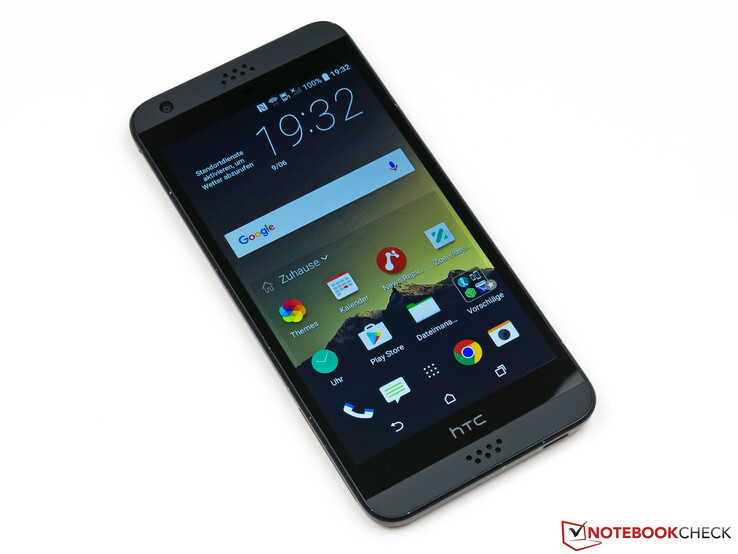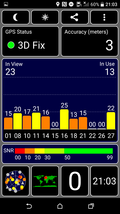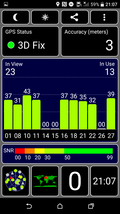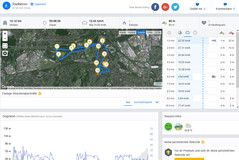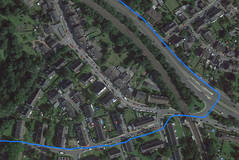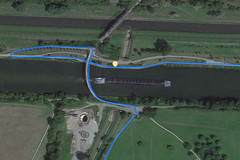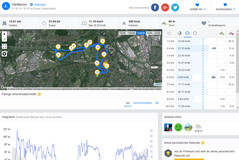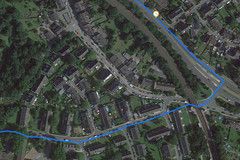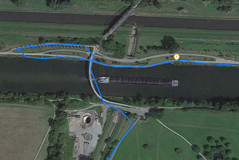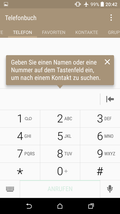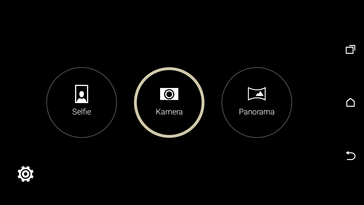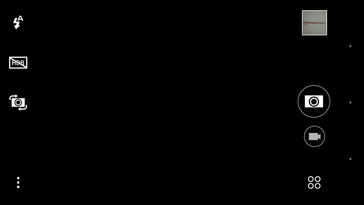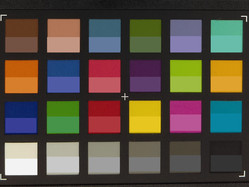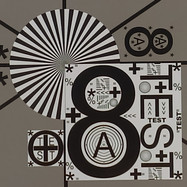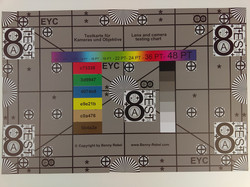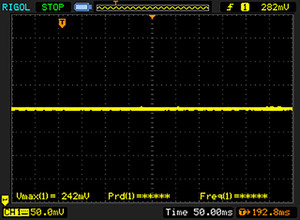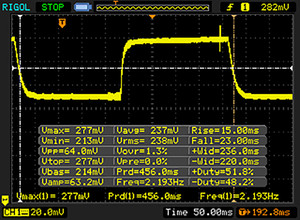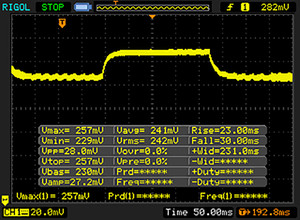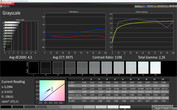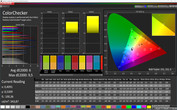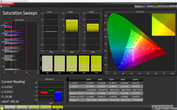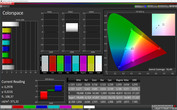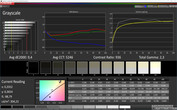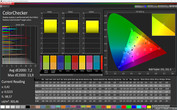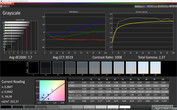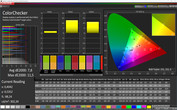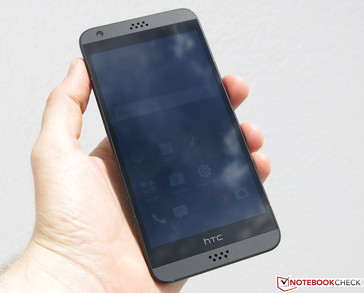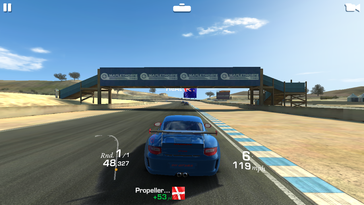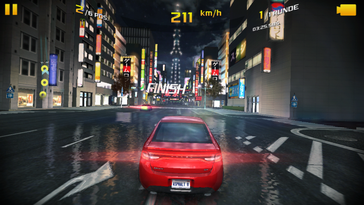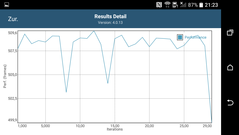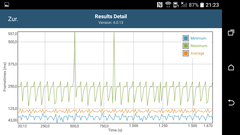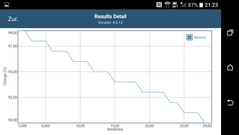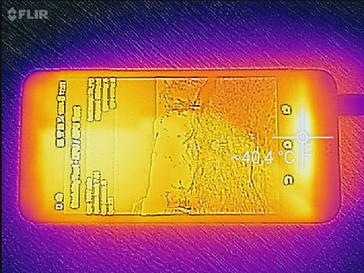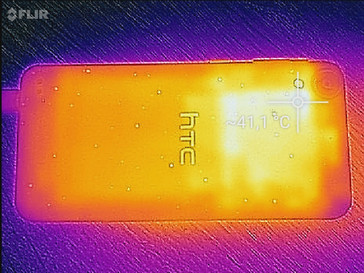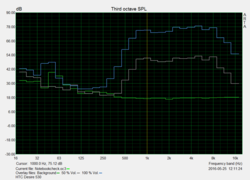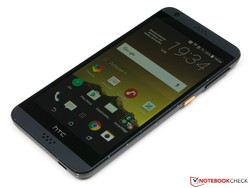HTC Desire 530 Smartphone Review
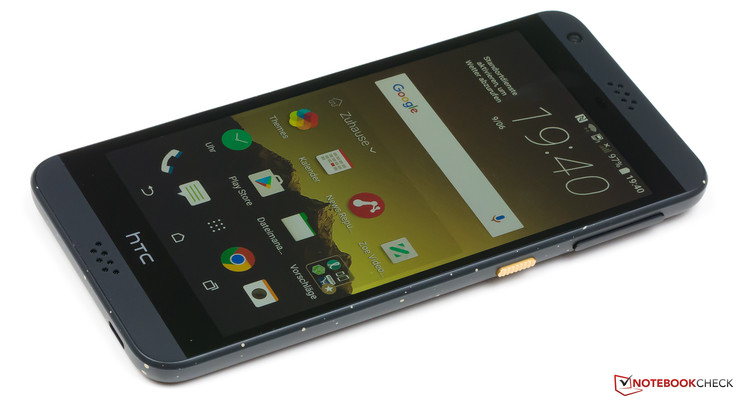
For the original German review, see here.
The Desire 530 offers something that even the considerably higher priced HTC 10 - the manufacturer's top model - cannot offer: Uniqueness. The color options "gray remix" and "white remix" adorn the smartphone's casing with randomly splashed contrasting colors. However, the handsets are also available in the basic color if the buyer does not like this pattern. With Qualcomm's Snapdragon 210, this eye-catching casing does not carry a particularly strong SoC and the RAM configuration of 1.5 GB is not generous. On the other hand, a decent 16 GB of storage and the option of expanding this via micro-SD slot are on board.
Currently, the review sample is sold at market prices starting at approximately 185 Euros (~$205) Thus, price wise it does not compete with the recently released Huawei P9 Lite and ZTE Blade V7 mid-range models, but rather with the former Huawei P8 Lite and ZTE Blade V6 whose prices have dropped significantly. Other rivals are Samsung's Galaxy J3 (2016), LG's Class and Microsoft's Lumia 650 powered by Windows Phone operating system.
Case
While the width of 70.9 millimeters (~2.8 in) is still within the usual range for smartphones with a 5-inch screen, with a length of 146.9 millimeters (~5.8 in), HTC's Desire 530 is 4 to 5 millimeters (~0.16 to 0.2 in) longer than most other rivals. It is 8.3 millimeters (~0.33 in) tall (approx. 9.1 mm/~0.36 in in the camera's area) and its sides are relatively high. Therefore, although the handset gives a robust impression, it does not look particularly elegant.
The various, differently sized, gold-colored speckles and the matching design of the power button set color accents on the dark-gray plastic unibody. The glass surface on the front is framed by a matte area near the speakers' openings. Overall, the build quality is acceptable, but the handset does not really feel high-quality due to the choice of materials.
The stability of the Desire 530 is only average. It can be warped slightly and moderate pressure on the touchscreen and handset's back causes wave formation on the screen. However, it is positive that the review sample does not produce noise then. The maintenance options are limited to the two card slots on the side; the user cannot replace the battery.
Connectivity
With 16 GB of storage, the Desire 530 offers an appropriate storage capacity for the price range. The user still has about 10 GB for personal use in the state of delivery. According to the manufacturer, the micro-SD slot support cards of up to 2 TB capacity - since cards with a maximum of 256 GB are currently available, the user is perfectly set up for the future. Although the smartphone does not support moving apps to the memory card, thanks to Android 6.0 it can be formatted as an internal storage. However, HTC recommends using a fast micro-SD card with UHS Class 3 bus. This function cannot be utilized when a slower UHS Class 1 card is inserted.
In terms of connectivity, the Desire 530 fulfills only the basic needs: A 3.5 mm headset jack is installed for audio output, and a micro-USB port is integrated for data sharing. The latter does not support OTG. Although Wi-Fi Direct is installed, transmitting images via Miracast is not possible. However, media can be streamed via DLNA. Some users will also miss the notification LED found in many Android devices.
Software
HTC has equipped the Desire 530 with the latest Android 6.0.1 Marshmallow ex-factory and as usual covers it with its own UI, HTC Sense. Compared with Google's Android version, it provides other icons, backgrounds and widgets. Furthermore, there is a news feed page on the left of the home screen which can be disabled if required. Another striking modification concerns the app drawer through which the user scrolls vertically rather than horizontally.
In addition to the usual Google software, HTC has preloaded several third-party programs. Facebook and Facebook Messenger, News Republic and Instagram apps are on the smartphone ex-factory. Proprietary apps, such as a video and image editor, are also found. None of these can be uninstalled and can only be disabled in the settings. However, the fact that they can be updated in Google's Play Store is a special feature.
Communication & GPS
HTC's Desire 530 communicates with Wi-Fi networks only in the 2.4 GHz frequency band. Nevertheless, a maximum gross transmission rate of 150 Mbit/s was accomplished in the test using an Asus RT-AC56U router. The range was inconspicuously good. The mobile wireless module supports diverse wireless standards. The LTE frequencies commonly used in Germany are among them (band 3, 7 & 20). Data can be downloaded at a maximum of 150 Mbit/s and uploaded at 51 Mbit/s in the Cat4 standard. Bluetooth 4.1 and NFC are available for near field communication.
The integrated GPS module found the user's position quickly in the outdoors. It only needed a little longer in the upper story of a building. The smartphone's accuracy of up to 3 meters (~9.9 ft) in both cases was quite decent. We took the Desire 530 along with Garmin's Edge 500 GPS bike computer on a bike ride for a better evaluation of the handset's navigation capabilities. The smartphone did not exhibit any major weaknesses. In direct comparison of the two devices, there were straight-lined shortcuts in some places, e.g. crossing the bridge, which are due to less frequent position updates. The total difference between the two devices is only about 110 meters (~361 ft), which is less than 1%. Thus, the Desire 530 should be quite suitable for navigation.
Telephone & Call Quality
The phone app in the Desire 530 offers a relatively wide range of functions on 5 sub-pages. This includes an extensive call list, keypad for entering phone numbers directly, favorite lists and direct access to contacts saved in the phone book.
The smartphone produces a quite natural sound via the earpiece during normal calls. Only minor static noise marred it slightly. The other call party could hear us clearly. The integrated hands-free mode in HTC's Desire 530 offers a decent, though not very loud sound. The contact complained about a too quiet and tinny sounding voice in this mode. The included headset is good and both callers could be heard clearly, but the transmitted sound is slightly more muffled on both sides than when using the earpiece. Overall, we can confirm HTC's Desire 530 has a decent telephony performance, especially since no irregularities were observed in reception.
Cameras
According to HTC's product description, both cameras in the Desire 530 shoot brilliant photos. The first doubts arise when reading the specification: With 8 megapixels and an aperture of f/2.4 or 5 megapixels and f/2.8 in the webcam, the review sample cannot outbid any of the comparison models. However, as usual, we took various test photos since figures are not inevitably an indicator for image quality.
The primary camera gives a category-typical impression. Although the resolution is sufficient for smaller prints, visible flaws are seen in full-screen views on a large PC monitor. Details – flora in particular - blur visibly (scene 2). Furthermore, the color saturation of our sample photo of a bridge (scene 1) is very low in the darker areas - the photo is almost monochrome here. The Desire 530 copes decently indoors (scene 3), although photos blur more frequently in low-light conditions.
The webcam's photos are also typical of the category. Under ideal light conditions, relatively many details can be recognized in the foreground. However, the pictures become increasingly vague as the ambient light is dimmed. The quality is acceptable for occasional selfies and posting on social media platforms, especially since an optional software soft-focus, "Makeup Level", is often applied in these cases.
Both cameras record videos in 720p at 30 frames per second. The colors look very rich, but the videos cannot compete with Full HD recordings of better equipped smartphones in terms of detail drawing. It is also too bad that the primary camera's auto focus is not active during recordings. Overall, the soundtrack sounds pleasingly natural, although a background noise is heard for about two and a half seconds at the beginning of every recording. Furthermore, the stereo balance of our review sample was unbalanced and the right channel sounded slightly louder.
The camera apps do not provide the user with setting options for ISO rates and white balance as found in, for example, Samsung's Galaxy J3 (2016). However, HDR and a panorama mode are present. The latter shoots almost transition-free panoramas with a width of just less than 180° - however, the vertical resolution is clearly reduced and the photos look very dark.
Overall, both cameras deliver a category-typical average performance without any real highlights. Nevertheless, they should be enough for occasional snapshots for most users.
To test the color accuracy of the primary camera in the Desire 530, we compare a photo of X-Rite's ColorChecker Passport under controlled light conditions with the actual reference colors. The photo is not edited afterward, e.g. manual white balance.
It is very clear that the review sample displays most colors much darker and more saturated than they really are - particularly the red tones. Furthermore, the lightly brownish grayscale levels show that the entire photo has too warm a color temperature.
To evaluate the camera lens' reproduction performance and general resolution capacity, we take a full-frame photo of our test chart under defined artificial light. This shows that the primary camera - as already observed in the sample photos - does not have a particularly high resolution. On the other hand, the photo's homogeneity is a pleasant surprise. The sharpness hardly decreases even toward the corners. Some competing devices exhibit weaknesses here, for example Samsung's Galaxy J3 (2016).
Accessories & Warranty
In addition to the smartphone itself, a 5-watt plug (1 A/5 V) and a micro-USB cable, an in-ear headset and a wrist strap is found in the box of HTC's Desire 530. HTC does not have product-specific accessories for the tested model on the German market in its lineup. However, multi-colored Snap Case covers that are available in some regions are found on the manufacturer's product page.
HTC includes a two-year warranty for its smartphone. However, this is limited to one year for the included accessories.
Input Devices & Handling
The default keyboard preloaded by HTC, "HTC Sense Input", fills the available space on the screen well. We also liked the fact that the middle keys are slightly larger than standard for better accessibility with the thumb for inputting text in landscape mode. However, after initial setup, a QWERTY keyboard was displayed despite the German language setting. It was possible to switch to the standard German QWERTZ layout via the option menu afterward. The relatively inaccurate vibration feedback can be completely disabled should the user find it more annoying than helpful. Text inputting via swipe is also possible.
The touchscreen made a good impression in the test. Fingers glide smoothly over its sleek surface, making it easy to input accurately. The few physical keys have a clearly defined pressure point and are fitted with little play in the casing. It is also pleasing that the power button's waved texture differentiates it palpably from the volume control above it. The position sensor quickly detects rotation when the smartphone is turned.
It is also subjectively pleasing that the user can navigate through the different menus smoothly despite the installed entry-level hardware. Most preloaded apps also start without much delay. Then again, installing larger programs is noticeably sluggish and the sometimes prolonged waiting times when browsing on the Internet is not as pleasing.
Display
A 5-inch LCD screen with a resolution of 1280x720 pixels is installed in HTC's Desire 530. This results in a pixel density of 294 PPI. It is on par with all the other rivals. Thus, pixilation is not visible at a normal seating distance and the display looks sufficiently sharp.
The average maximum brightness on a completely white screen is 376 cd/m². This rate changes only marginally to a somewhat lower 366 cd/m² when we measure the screen with equally distributed dark and bright areas (average picture level/APL50). Activating the Desire 530's light sensor does not present any brightness reserves, either. Although it outshines two of the rivals also equipped with IPS panels, namely Huawei's P8 Lite and ZTE's Blade V6, it cannot outbid the much brighter LG Class and Samsung Galaxy J3 (2016) with a manual outdoor mode. Due to the relatively low black level of 0.32 cd/m² for IPS conditions, the Desire 530's screen does not offer a high contrast with 1172:1. Furthermore, no clouding was visible when dark objects were displayed on the screen.
Beyond that, it is pleasing that the installed screen does not use PWM for controlling brightness and therefore flickering is not visible.
| |||||||||||||||||||||||||
Brightness Distribution: 91 %
Center on Battery: 375 cd/m²
Contrast: 1172:1 (Black: 0.32 cd/m²)
ΔE ColorChecker Calman: 6 | ∀{0.5-29.43 Ø4.77}
ΔE Greyscale Calman: 4.5 | ∀{0.09-98 Ø5}
Gamma: 2.26
CCT: 6975 K
| HTC Desire 530 IPS, 1280x720, 5" | Samsung Galaxy J3 2016 Super AMOLED, 1280x720, 5" | Huawei P8 lite IPS, 1280x720, 5" | ZTE Blade V6 IPS, 1280x720, 5" | LG Class IPS, 1280x720, 5" | Microsoft Lumia 650 OLED, 1280x720, 5" | |
|---|---|---|---|---|---|---|
| Screen | ||||||
| Brightness middle (cd/m²) | 375 | 295 -21% | 365 -3% | 336 -10% | 518 38% | 349 -7% |
| Brightness (cd/m²) | 376 | 299 -20% | 353 -6% | 315 -16% | 492 31% | 353 -6% |
| Brightness Distribution (%) | 91 | 96 5% | 93 2% | 81 -11% | 91 0% | 92 1% |
| Black Level * (cd/m²) | 0.32 | 0.42 -31% | 0.39 -22% | 0.51 -59% | ||
| Contrast (:1) | 1172 | 869 -26% | 862 -26% | 1016 -13% | ||
| Colorchecker dE 2000 * | 6 | 5.8 3% | 5.2 13% | 8.29 -38% | 5.41 10% | 2.6 57% |
| Colorchecker dE 2000 max. * | 9.5 | 8.6 9% | 8.76 8% | 8.2 14% | ||
| Greyscale dE 2000 * | 4.5 | 4.8 -7% | 5.85 -30% | 8.57 -90% | 7.67 -70% | 1.8 60% |
| Gamma | 2.26 97% | 1.84 120% | 2.17 101% | 1.96 112% | 2.19 100% | 2.06 107% |
| CCT | 6975 93% | 6252 104% | 7252 90% | 8172 80% | 8521 76% | 6542 99% |
| Color Space (Percent of AdobeRGB 1998) (%) | 70.86 | |||||
| Color Space (Percent of sRGB) (%) | 91.25 | 89.7 |
* ... smaller is better
Screen Flickering / PWM (Pulse-Width Modulation)
| Screen flickering / PWM not detected | |||
In comparison: 53 % of all tested devices do not use PWM to dim the display. If PWM was detected, an average of 8084 (minimum: 5 - maximum: 343500) Hz was measured. | |||
Display Response Times
| ↔ Response Time Black to White | ||
|---|---|---|
| 38 ms ... rise ↗ and fall ↘ combined | ↗ 15 ms rise | |
| ↘ 23 ms fall | ||
| The screen shows slow response rates in our tests and will be unsatisfactory for gamers. In comparison, all tested devices range from 0.1 (minimum) to 240 (maximum) ms. » 96 % of all devices are better. This means that the measured response time is worse than the average of all tested devices (20.2 ms). | ||
| ↔ Response Time 50% Grey to 80% Grey | ||
| 53 ms ... rise ↗ and fall ↘ combined | ↗ 23 ms rise | |
| ↘ 30 ms fall | ||
| The screen shows slow response rates in our tests and will be unsatisfactory for gamers. In comparison, all tested devices range from 0.165 (minimum) to 636 (maximum) ms. » 90 % of all devices are better. This means that the measured response time is worse than the average of all tested devices (31.6 ms). | ||
The panel displays grayscale levels with an average DeltaE deviation of 4.5 and colors with a DeltaE deviation of 6 in standard settings (ideal range <3 in both cases). The color temperature of 6975 K is slightly above the ideal rate of 6500 K. When required, the temperature can be increased or reduced by several levels in the display options. However, the color aberrations increase then. With these results the Desire 530 achieves an average placement in the comparison. Only Microsoft's Lumia 650 manages a better reproduction, while ZTE's Blade V6 is much poorer.
It is recommended to look for a place in the shade with the Desire 530 for trouble-free outdoor use. Although the screen is legible with some effort in direct sunlight, all reflections have to be avoided to recognize displayed contents.
The review sample presents weaknesses in viewing angle stability. On the one hand, brightness drops visibly very early, and on the other, colors shift to either warmer or cooler color tones from certain viewing angles. We observed similar behavior in ZTE's Blade V6. It is a positive that colors never invert.
Performance
The Snapdragon 210 SoC by Qualcomm is the heart piece of the Desire 530. It clocks at a maximum of 1.1 GHz and has four entry-level Cortex A7 cores. A total of 1.5 GB working memory supports the processor. An Adreno 304 GPU is responsible for video output. Since the 3DMark Slingshot test based on OpenGL ES 3.0 did not present any valid scores, it is not listed in the comparison charts. The smartphone generally does not support benchmarks based on OpenGL ES 3.1.
The review sample achieves the last place in PCMark, AnTuTu and Geekbench. It also scores very poorly in Basemark OS II. However, the extremely bad Web Score is mainly responsible for this. To rule out that it is just a temporary error, we performed the benchmark several times and always achieved the same outcome. Compared with the CPU, the GPU does a slightly better job in the comparison group, which is reflected in the 3DMark tests. At least, the Desire 530 can sometimes keep Samsung's Galaxy J3 (2016) in check.
| PCMark for Android - Work performance score (sort by value) | |
| HTC Desire 530 | |
| Samsung Galaxy J3 2016 | |
| Huawei P8 lite | |
| LG Class | |
| AnTuTu v6 - Total Score (sort by value) | |
| HTC Desire 530 | |
| Samsung Galaxy J3 2016 | |
| Microsoft Lumia 650 | |
| Geekbench 3 | |
| 32 Bit Multi-Core Score (sort by value) | |
| HTC Desire 530 | |
| Samsung Galaxy J3 2016 | |
| ZTE Blade V6 | |
| LG Class | |
| 32 Bit Single-Core Score (sort by value) | |
| HTC Desire 530 | |
| Samsung Galaxy J3 2016 | |
| ZTE Blade V6 | |
| LG Class | |
| GFXBench (DX / GLBenchmark) 2.7 | |
| T-Rex Onscreen (sort by value) | |
| HTC Desire 530 | |
| Samsung Galaxy J3 2016 | |
| Huawei P8 lite | |
| ZTE Blade V6 | |
| LG Class | |
| Microsoft Lumia 650 | |
| 1920x1080 T-Rex Offscreen (sort by value) | |
| HTC Desire 530 | |
| Samsung Galaxy J3 2016 | |
| Huawei P8 lite | |
| ZTE Blade V6 | |
| LG Class | |
| Microsoft Lumia 650 | |
| GFXBench 3.0 | |
| 1920x1080 1080p Manhattan Offscreen (sort by value) | |
| HTC Desire 530 | |
| ZTE Blade V6 | |
| LG Class | |
| on screen Manhattan Onscreen OGL (sort by value) | |
| HTC Desire 530 | |
| ZTE Blade V6 | |
| LG Class | |
| 3DMark | |
| 1280x720 offscreen Ice Storm Unlimited Score (sort by value) | |
| HTC Desire 530 | |
| Samsung Galaxy J3 2016 | |
| Huawei P8 lite | |
| ZTE Blade V6 | |
| 1280x720 offscreen Ice Storm Unlimited Graphics Score (sort by value) | |
| HTC Desire 530 | |
| Samsung Galaxy J3 2016 | |
| Huawei P8 lite | |
| ZTE Blade V6 | |
| 1280x720 offscreen Ice Storm Unlimited Physics (sort by value) | |
| HTC Desire 530 | |
| Samsung Galaxy J3 2016 | |
| Huawei P8 lite | |
| ZTE Blade V6 | |
| 1280x720 Ice Storm Standard Physics (sort by value) | |
| HTC Desire 530 | |
| Samsung Galaxy J3 2016 | |
| Huawei P8 lite | |
| ZTE Blade V6 | |
| LG Class | |
| 1280x720 Ice Storm Standard Graphics (sort by value) | |
| HTC Desire 530 | |
| Samsung Galaxy J3 2016 | |
| Huawei P8 lite | |
| ZTE Blade V6 | |
| LG Class | |
| 1280x720 Ice Storm Standard Score (sort by value) | |
| HTC Desire 530 | |
| Samsung Galaxy J3 2016 | |
| Huawei P8 lite | |
| ZTE Blade V6 | |
| LG Class | |
The Octane V2, WebXPRT 2015 and JetStream 1.1 browser benchmarks confirm that the poor score in the Basemark OS II web test is not completely made of thin air. Sometimes the Desire 530 is clearly in the last place. Only in the Mozilla Kraken benchmark do ZTE's Blade V6 and Microsoft's Lumia 650 pass the finish line somewhat later. Subjectively, the review sample sometimes needs a few extra seconds for displaying complex website completely when browsing.
| Mozilla Kraken 1.1 - Total (sort by value) | |
| HTC Desire 530 | |
| Samsung Galaxy J3 2016 | |
| Huawei P8 lite | |
| ZTE Blade V6 | |
| LG Class | |
| Microsoft Lumia 650 | |
| Octane V2 - Total Score (sort by value) | |
| HTC Desire 530 | |
| Samsung Galaxy J3 2016 | |
| Huawei P8 lite | |
| ZTE Blade V6 | |
| LG Class | |
| Microsoft Lumia 650 | |
| WebXPRT 2015 - Overall (sort by value) | |
| HTC Desire 530 | |
| Samsung Galaxy J3 2016 | |
| Huawei P8 lite | |
| LG Class | |
| Microsoft Lumia 650 | |
| JetStream 1.1 - Total Score (sort by value) | |
| HTC Desire 530 | |
| Samsung Galaxy J3 2016 | |
* ... smaller is better
The Desire 530's internal storage is roughly on par with that of its rivals in the AndroBench 3 write and read tests. However, we have to note that ZTE's Blade V6 achieves twice the read speed, and Samsung's Galaxy J3 (2016) only operates half as fast. The Desire is not quite as impressive in random write and, with the exception of LG's Class, all comparison devices outperform it. The review sample also comes in last in the BaseMark OS II memory test. Both Huawei's P8 Lite and ZTE's Blade V6 achieve a roughly three times as high a score in this benchmark.
We tested the micro-SD slot's interface with our Toshiba Exceria Pro M401 (THN-M401S0640E2) reference card (UHS-I Class 3, max. read: 95 MB/s, max. write: 80 MB/s). Both the sequential read rate of 35.56 MB/s as well as the sequential write rate of 18.22 MB/s are below average. This is too bad, particularly since the memory card can also be used as internal storage, and the potential of fast cards is thus clearly limited.
| AndroBench 3-5 | |
| Random Write 4KB (sort by value) | |
| HTC Desire 530 | |
| Samsung Galaxy J3 2016 | |
| Huawei P8 lite | |
| ZTE Blade V6 | |
| LG Class | |
| Random Read 4KB (sort by value) | |
| HTC Desire 530 | |
| Samsung Galaxy J3 2016 | |
| Huawei P8 lite | |
| ZTE Blade V6 | |
| LG Class | |
| Sequential Write 256KB (sort by value) | |
| HTC Desire 530 | |
| Samsung Galaxy J3 2016 | |
| Huawei P8 lite | |
| ZTE Blade V6 | |
| LG Class | |
| Sequential Read 256KB (sort by value) | |
| HTC Desire 530 | |
| Samsung Galaxy J3 2016 | |
| Huawei P8 lite | |
| ZTE Blade V6 | |
| LG Class | |
| Sequential Write 256KB SDCard (sort by value) | |
| HTC Desire 530 | |
| Samsung Galaxy J3 2016 | |
| Sequential Read 256KB SDCard (sort by value) | |
| HTC Desire 530 | |
| Samsung Galaxy J3 2016 | |
| BaseMark OS II - Memory (sort by value) | |
| HTC Desire 530 | |
| Samsung Galaxy J3 2016 | |
| Huawei P8 lite | |
| ZTE Blade V6 | |
| LG Class | |
| Microsoft Lumia 650 | |
Games
An Adreno 304 GPU is responsible for video output in HTC's Desire 530. Its performance is situated in the entry-level sector. Thus, demanding games such as "Real Racing 3" or "Asphalt 8" do not run quite smoothly in high details. However, a sufficiently high frame rate can be achieved when settings are reduced. Although "Asphalt 8" only runs at an average of 31 FPS, it can be played without major restrictions, if the user can tolerate some minor stutters. The integrated position senor and reliably functioning touchscreen did not cause problems in gaming situations.
| Real Racing 3 | |||
| Settings | Value | ||
| high | 20 fps | ||
| low | 42 fps | ||
| Asphalt 8: Airborne | |||
| Settings | Value | ||
| high | 13 fps | ||
| very low | 21 fps | ||
Emissions
Temperature
The Desire 530 does not break any records with maximum load temperatures of approximately 38 °C (~100 °F), but it does not heat up significantly. Only Samsung's Galaxy J3 (2016) does a much better job among the opponents; Huawei's P8 Lite reaches the highest temperatures.
To exclude performance throttling during permanent load, we performed the battery test of GFXBench that launches the T-Rex test thirty times successively and logs the available performance and battery consumption. Since the single performance rates are within a fluctuation range of just 2%, throttling is not an issue for the Desire 530.
(+) The maximum temperature on the upper side is 37.2 °C / 99 F, compared to the average of 35.2 °C / 95 F, ranging from 21.9 to 247 °C for the class Smartphone.
(+) The bottom heats up to a maximum of 38.4 °C / 101 F, compared to the average of 34 °C / 93 F
(+) In idle usage, the average temperature for the upper side is 31.2 °C / 88 F, compared to the device average of 32.9 °C / 91 F.
Speaker
The Desire 530's speaker is located on the casing's front, below the screen. Hands will rarely cover it here and its sound will not change when the smartphone is placed on a surface.
Subjectively, the speaker produces a somewhat thin sound characteristic without noteworthy bass. The clarity of speech is nevertheless very decent. Furthermore, annoying distortions are not produced even at maximum volume. With a measured 87.4 dB(A) in the Pink Noise test, it is also sufficiently high although other smartphones seem to render music slightly louder. Objectively, the speaker barely uses the frequency range below 500 Hz, but at least shows an almost linear frequency response above 700 Hz up to about 8 kHz.
The supplied headset pleases with a quite natural sound impression. However, fans of powerful bass playback will not be very happy with it. Optionally, it is also possible to enable "HTC BoomSound" for improving the sound.
Energy Management
Power Consumption
According to our synoptic table, the Desire 530 clearly draws the short straw compared with its rivals. However, we have been using a new and more accurate instrument for some months, making the rate of Huawei's P8 Lite, ZTE's Blade V6 and LG's Class only partially comparable with the other smartphones.
The 5-watt power supply included for the review sample needed approximately 2 hours and 20 minutes to fully recharge the battery.
| Off / Standby | |
| Idle | |
| Load |
|
Key:
min: | |
| HTC Desire 530 2200 mAh | Samsung Galaxy J3 2016 2600 mAh | Huawei P8 lite 2200 mAh | ZTE Blade V6 2200 mAh | LG Class 2050 mAh | Microsoft Lumia 650 2000 mAh | |
|---|---|---|---|---|---|---|
| Power Consumption | 50% | 9% | 21% | 22% | 44% | |
| Idle Minimum * (Watt) | 1.58 | 0.96 39% | 1.4 11% | 1.2 24% | 1.2 24% | 0.7 56% |
| Idle Average * (Watt) | 2.59 | 1.14 56% | 2.3 11% | 1.8 31% | 1.9 27% | 1.1 58% |
| Idle Maximum * (Watt) | 2.66 | 1.23 54% | 2.5 6% | 2.1 21% | 2.2 17% | 1.18 56% |
| Load Average * (Watt) | 5.22 | 2.45 53% | 3.9 25% | 4.1 21% | 3.1 41% | 4.04 23% |
| Load Maximum * (Watt) | 5.67 | 2.92 49% | 6 -6% | 5.1 10% | 5.6 1% | 4.07 28% |
* ... smaller is better
Battery Runtime
Despite its relatively high power consumption, HTC's Desire 530 can serve with decent battery runtimes. Although it does not achieve the very good rates of Samsung's Galaxy J3 (2016) with 7 hours and 5 minutes, it can - even if only marginally - outrun the other comparison devices, especially in the practical Wi-Fi test. It is situated midfield in the "Big Buck Bunny" video playback test.
Enabling the energy-savings mode that limits CPU performance, screen brightness and location services, and disabling vibration feedback retrieves a little more runtime from the smartphone. An even longer runtime can be achieved with the "Extreme Power Saving" mode. However, the smartphone's functions are then also extremely limited. Only predefined programs, such as SMS, email and the calendar app, are then available.
| HTC Desire 530 2200 mAh | Samsung Galaxy J3 2016 2600 mAh | Huawei P8 lite 2200 mAh | ZTE Blade V6 2200 mAh | LG Class 2050 mAh | Microsoft Lumia 650 2000 mAh | |
|---|---|---|---|---|---|---|
| Battery runtime | 32% | -24% | -8% | 1% | -10% | |
| Reader / Idle (h) | 18.6 | 20.2 9% | 11.9 -36% | 16.3 -12% | 15.2 -18% | |
| H.264 (h) | 7.6 | 9.8 29% | 6.2 -18% | 7.1 -7% | 10.5 38% | 8.5 12% |
| WiFi v1.3 (h) | 7.1 | 8.4 18% | 5.9 -17% | 6.7 -6% | 7 -1% | 5.8 -18% |
| Load (h) | 4.2 | 7.2 71% | 3.2 -24% | 3.8 -10% | 3.3 -21% | 3.6 -14% |
Pros
Cons
Verdict
Whether HTC's attempt at making a unique design statement with the Desire 530 has been successful is probably a matter of taste. Regardless of that, the casing pleases with its decent build and good hardware buttons. However, it hardly conveys a high-quality feeling due to the choice of materials, and in particular since it is quite large for a smartphone with a 5-inch screen. The modern operating system, the option of expanding the storage via micro-SD card and the decent battery life in particular, are all positive. However, it is too bad that the handset only offers average fare in terms of cameras and the not quite viewing angle stable panel. Furthermore, the overall performance is often lower than that of the comparison devices.
HTC's Desire 530 adds a splash of color to the rather broad mass of affordable Android devices. However, the smartphone barely offers any technical highlights. Buyers will therefore probably opt for the handset for design reasons and the modern Android user interface.
Good alternatives for the Desire 530 are found in the opponents named in the test. Samsung's Galaxy J3 (2016) is currently about 35 Euros (~$39) cheaper than the review sample with a price of 150 Euros (~$166). It also serves with a longer battery life, superb AMOLED screen and removable battery. On the other hand, the buyer will not find a light sensor or the latest Android operating system. When the best possible performance is important, it is worthwhile looking at ZTE's Blade V6 and Huawei's P8 lite mid-range models. Their prices have dropped significantly.
HTC Desire 530
- 06/22/2016 v5.1 (old)
Andreas Kilian




